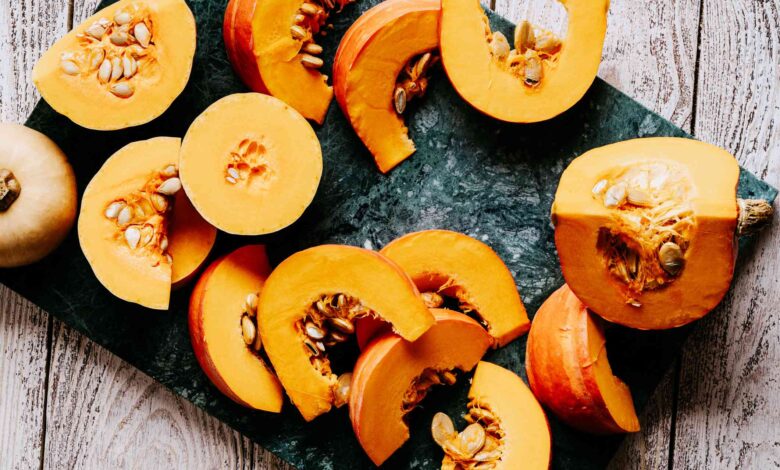6 Health Benefits of Pumpkins

From pumpkin spice lattes to pumpkin bread, pumpkin-flavored items are popular for the cozier fall months. But real pumpkin is more than a flavor enhancer for seasonal treats, it has impressive health benefits.
Pumpkin is a type of winter squash that belongs to the Cucurbitaceae family. It is native to North and Central America and has smooth, slightly ribbed skin and deep yellow to orange coloration. Pumpkins are renowned for their versatile use in cooking, from soups and salads to preserves and pies, and they are packed with vitamins, minerals, and antioxidants, making them a nutritious addition to any diet.
This delicious fruit is a cousin to the melon family. And like many melons (like watermelon), every part of the pumpkin can be consumed, including the seeds and skin, making it a fantastic choice for people focused on minimizing food waste. Pumpkin can also be enjoyed as a canned puree, helping pumpkin lovers skip any prep work when they want a pumpkin boost in their smoothie, muffin, and other recipes.
If you are a pumpkin fan and have ever wondered what eating this delicious food can do for your health and wellness, keep reading to learn the top six health benefits of eating pumpkin.
Fiber is a key nutrient that supports gut health by regulating the gut microbiota and helping promote regular bowel movements. One cup of canned pumpkin puree has a whopping 7 grams (g) of fiber, which is close to 30% DV.
Some data shows that pumpkin peel contains alcohol-insoluble polysaccharides, which tend to reduce bile acid and support the growth of gut microbiota.
Since the development of certain cancers is linked to increased oxidative stress, a diet rich in antioxidants is recommended to reduce cancer risk.
Pumpkin has been investigated for its anti-cancerous properties, in part, because of its rich antioxidant content. It has been reported that the risk of several types of cancer, such as breast, rectal, and lung cancer, is lower among those who consume more pumpkin seeds.
And other data has suggested that pumpkin may inhibit the development of prostate cancer, although quality human studies are needed to confirm this relationship.
Pumpkin is a natural source of many immune health-supporting nutrients, including vitamin C, zinc, and selenium. And since proper hydration can impact immune health as well, the fact that pumpkin is approximately 90% water helps highlight another reason why this food can be an important part of an immune health-supporting diet.
Finally, since 70% of our immune system is in our gut, supporting gut health by eating fiber foods, like pumpkin, can impact our immune health as well.
Data consistently shows that increased fruit consumption and non-starchy vegetables are linked to weight loss.
Including pumpkin in your diet is an easy way to include more produce in your diet. One cup of cubed raw pumpkin contains very few calories—around 30 calories per cup. In fact, the fiber found in pumpkin may also help support weight management, as this nutrient has been shown to support satiety.
Pumpkin is packed with the eye health-supporting vitamin A and the carotenoids lutein and zeaxanthin.
Lutein and zeaxanthin are the only dietary carotenoids that accumulate in the retina, specifically the macula, and are called macular pigments. Consumption of these carotenoids has been shown to reduce the risk of developing macular degeneration.
Pumpkin is a natural source of many nutrients that supports heart health, including potassium, calcium, and magnesium. These three nutrients are emphasized in the Dietary Approach to Stop Hypertension (DASH Diet), a diet that helps people manage their hypertension via their dietary choices.
Pumpkin is also a flavorful food that is low in sodium, another aspect of this food that may benefit healthy blood pressure.
Here are the nutrition facts of one cup of raw cubed pumpkin, according to the USDA.
- Calories: 30
- Protein: 1.16 g
- Fat: 0 g
- Carbohydrates: 7.5 g
- Fiber: 0.58 g
- Calcium: 24 milligrams (mg)
- Iron: 1 mg
- Magnesium: 13 mg
- Vitamin C: 10 mg
While pumpkin is generally safe and healthy to consume, there are a few potential risks and side effects to consider.
- May cause digestive issues: Pumpkins can be high in fiber, which, if over-consumed, may lead to bloating, gas, and stomach cramps.
- May cause an allergic reaction: While it isn’t common, some people do have an allergy to pumpkins. If you fall into this category, it is wise to avoid this gourd.
- May cause food borne illness: Raw pumpkins that are not washed properly may contain bacteria, viruses, and other pathogens, so it’s essential to ensure they are thoroughly washed and properly cooked before eating.
Here are a few tips for consuming pumpkin:
- Pumpkin puree: You can use it in a variety of sweet and savory dishes, from pies and pancakes to soups and stews.
- Roasted pumpkin: Cut the pumpkin into slices, drizzle with olive oil, sprinkle some salt, and roast it in the oven.
- Pumpkin seeds: Don’t throw them away; pumpkin seeds are packed with nutrients. You can roast them for a healthy, crunchy snack.
- Pumpkin smoothie: Blend pumpkin puree with your favorite fruits, a bit of yogurt, and a dash of cinnamon for a healthy smoothie.
- Pumpkin soup: A bowl of warm, creamy pumpkin soup can be a comforting winter meal. Just blend cooked pumpkin with some broth and your choice of spices.
Pumpkin, a highly nutritious and versatile plant, holds a multitude of health benefits. It is rich in vitamins, such as vitamin A, which supports eye health, and vitamin C, which supports the immune system. Its high fiber content supports healthy digestion while its abundance of antioxidants may reduce the risk of chronic diseases.
Pumpkins are so much more than decor for your Fall-friendly front porch. Including pumpkin in your dishes may be a surprising addition, but your body will benefit from the nutrients it provides, and your taste buds will enjoy the cozy flavor it adds too.




